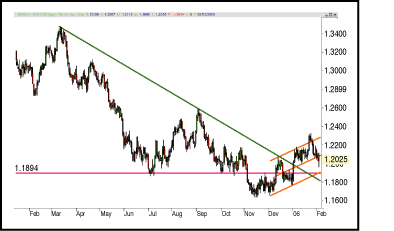- Expectations Of A Rangebound Market -
by Tony Juste
Expectations Of A Rangebound Market
Expectations have tremendous importance in the decisions of speculators, and that may lead them to ignore other variables of the market. Here's a recent story of the euro/US dollar.
After the release of the US unemployment report on February 3, 2006, the euro took a hit against the dollar as the pair dipped down below the 1.20 level for the first time in four weeks.
Remember that since a temporary bottom was hit in November 2005, the single currency started a semirally on a daily basis that might well be over for now. I call those an "expectations rally."
The break of the downtrend line (Figure 1) at the beginning of 2006 led speculators (and most daytraders) to think that the bearish tone that the pair had been in for the last seven to eight months might have ended, and that a new bullish rally could be just starting. Indeed, the euro confirmed the trendline break with a 130-pip rally in the next session, but failure to break through the upper line of the just-formed uptrend channel showed that bears were far from giving up. Reports on speculative positions showed a lack of direction in the market, with sentiment flipping from positive to negative almost every week.

Figure 1: a market driven by expectations. Although there is a bias to the upside, it's weak and it may be well worth your while to keep a close eye until a solid trend is in place.
But expectations continued to be built up on the hopes of a stronger euro, especially by daily-based chart trend-followers who were monitoring the price activity within the uptrend channel, expecting a breakout on the upside that would lead the quote up to 1.24/1.25. And on January 23, 2006, they were given the go-ahead signal. With a closing level just shy below 1.23 and the upper line of the channel broken, there was a clear long signal trigger they had to follow.
The following day saw a minor retracement, with price action giving back some of the recent gains but still trading above the upper line of the channel, indicating that the next leg on the upside should be on its way. The day after, price action again tested the highs for the month in another hope-building rally that many used to join the long side, as by that time expectations were just about to turn into reality. That day's daily closing level was a warning signal that the market was not ready for any trend being set up. But that was the point where expectations started to play an even more important role.
In the following days, as price came close to the middle line of the channel, long positions in the euro started to accumulate, though not by a great margin. Speculators certainly started to view price levels as more and more attractive. The test and bounce off the middle line of the channel was too good to be true, and the long/short ratio started to show speculators' preferences.
Right now, there is still a group of speculators caught up in and/or around the 1.22 level with expectations of an upside channel break. They are learning the hard way what expectations mean in trading and the damage they can do to their accounts. Expecting a solid trend when there are no other major indications going in that direction is a common situation most beginners face - that only some survive.
Calling the current euro/dollar market rangebound may sound confusing, but if you take a closer look, you can spot the differences between the current market's behavior and that of any period in 2005. In the current environment, any rally is confronted with decent retracements and no major levels have been broken after the downtrend line break. This has been called a "weak long" euro rally, and that might be right. Being more specific about the nature of the market, however, I would say that it is rangebound. Because expectations are leading the decisions of speculators (and daytraders), big market players are able to trigger stops easily, and no definite direction is being set.
There is no market where expectations mean more than a rangebound market. So far, 2006 has been driven by expectations, which are growing daily. Further, we can see them driving the price action at least until the end of the first half of the year. Although bias is still (weakly) on the upside, it would be better to be open-minded and try to spot as many opportunities as possible, either long or short, until a strong trend is in place.
Tony Juste is the forex advisor at FXstreet.com, a frequently visited foreign exchange portal. He contributes both as a technical commentator and advisor in currency-related topics. Prior to joining the forex marketplace in 1999, he was involved with trading stocks, futures, and options.
- See Editorial Resource Index
Originally published in the April 2006 issue of Technical Analysis of STOCKS & COMMODITIES magazine. All rights reserved. © Copyright 2005, Technical Analysis, Inc.
Return to April 2006 Contents
Originally published in the April 2006 issue of Technical Analysis
of STOCKS & COMMODITIES magazine. All rights reserved.
© Copyright 2006, Technical Analysis, Inc.